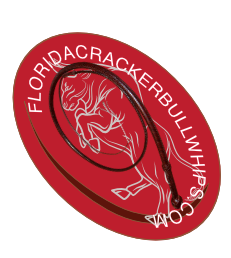
Floridacrackerbullwhips
High Quality Custom Made Whips In Kangaroo, Cowhide and Nylon for over 20 years.

Floridacrackerbullwhips
High Quality Custom Made Whips In Kangaroo, Cowhide and Nylon for over 20 years.
Learn how to properly care for your whip.
If your whip gets wet, allow it to air dry, do not apply heat to accelerate the drying process as this will damage the leather and cause the leather to crack. After the whip is dry apply good quality leather dressing to the whip according to the instructions listed below. I recommend Montana Pitch-Blend. Do not use neat’s foot oil on your whip unless you are very experienced with its application, this product if not applied correctly will cause the leather to lose its ability to breathe and in turn will cause the whip to retain to much moisture. If over applied it can also cause the leather fibers to swell, become weak and tear. Allow me to clarify what I mean by leathers ability to breathe. All leather contains a certain moisture content this moisture content will change due to the relative humidity of the atmosphere and the temperature of the whip.
Leathers ability to allow moisture to enter and exit the hide naturally is the leathers ability to breathe, all leather has this property. If too much oil is introduced in to a whip the leather will become saturated with the oil and will no longer be able to eliminate excess moisture. The trapped moisture will in time allow mold spores that randomly attach themselves to the leather to germinate, causing mold growth on the whip. Always remember less leather dressing is always better than too much.
Store your whip in a cool dry area with no greater than 60% relative humidity, damp humid conditions will foster mold growth and can cause the whip to rot. Be aware that abrasive surfaces will damage the leather of your whip, do not use your whip on paved or concrete surfaces, and if the surface will hurt your bare feet chances are it will hurt your whip also. If your whip gets dirty you can clean it with a good quality saddle soap and warm water. Use a sponge or soft brush to build lather with the saddle soap. Apply the lather to the whip with the sponge or the soft brush and scrub away the dirt. If hard stains are present a tooth brush can be used to scrub the stained area. Wet a rag and wring it out as much as possible wipe off the dirty lather with the damp cloth make sure to rinse the cloth out often and pay attention to remove the lather from the creases of the braid. After the whip has been cleaned and is still damp apply a light coat of leather dressing and allow the whip to air dry for 24 hours.
After the whip is dry use a soft lint free cloth and remove any leather dressing that has not been absorbed in to the whip. From time to time you will need to apply good quality leather dressing to your whip to keep the leather supple and prevent the leather from drying out and cracking. A good sign that it is time to treat your whip with leather dressing is if you notice that the leather is becoming lighter in color or the leather seems to be drying out. It is highly recommended that you only apply leather dressing to a clean whip, if the whip is duty the leather dressing will seal the dirt on the whip and over time this will damage the leather of the whip. To apply the leather dressing use a clean soft lint free cloth to apply a thin even cost of leather dressing over the entire whip, but don't overdo it too much of a good thing isn't good for your whip either.
Allow the leather dressing to soak in to the whip for 24 hours after that use a clean soft lint free cloth to remove any leather dressing that was not absorbed in to the whip before you use the whip. When the cracker on your whip wears out or requires replacement, click on the Cracker Replacement link for instructions on how to replace the cracker. As always if you have any questions regarding the care of your whip or anything else related to my whips do not hesitate to contact me.